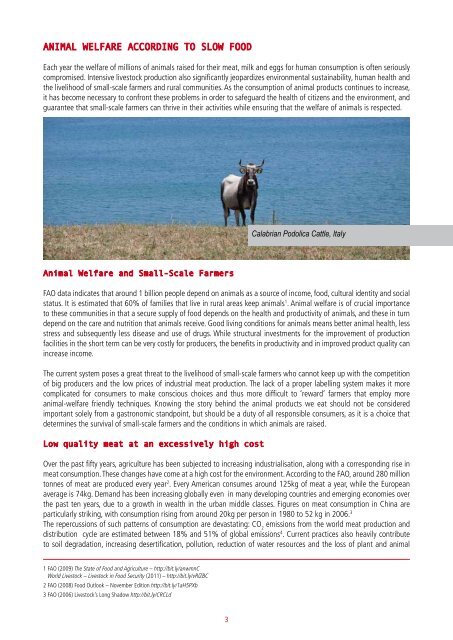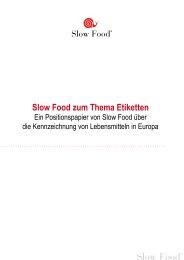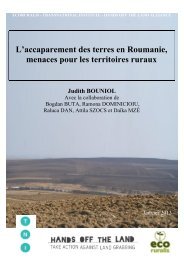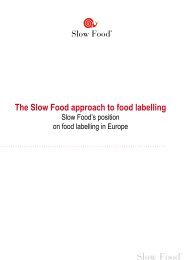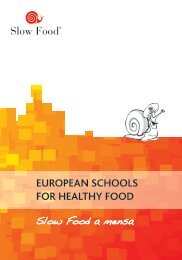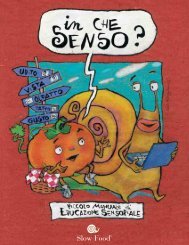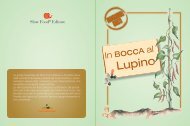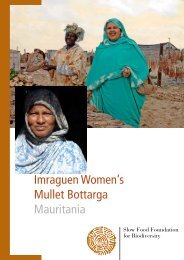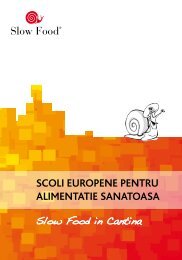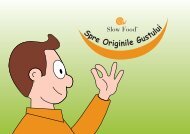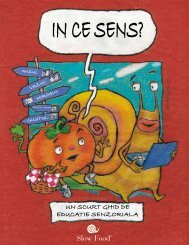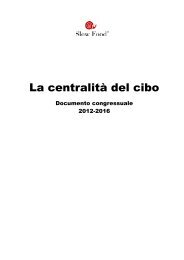Slow Food Policy Paper on Animal Welfare
Slow Food Policy Paper on Animal Welfare
Slow Food Policy Paper on Animal Welfare
You also want an ePaper? Increase the reach of your titles
YUMPU automatically turns print PDFs into web optimized ePapers that Google loves.
<strong>Animal</strong> <strong>Welfare</strong> According to <str<strong>on</strong>g>Slow</str<strong>on</strong>g> <str<strong>on</strong>g>Food</str<strong>on</strong>g><br />
Each year the welfare of milli<strong>on</strong>s of animals raised for their meat, milk and eggs for human c<strong>on</strong>sumpti<strong>on</strong> is often seriously<br />
compromised. Intensive livestock producti<strong>on</strong> also significantly jeopardizes envir<strong>on</strong>mental sustainability, human health and<br />
the livelihood of small-scale farmers and rural communities. As the c<strong>on</strong>sumpti<strong>on</strong> of animal products c<strong>on</strong>tinues to increase,<br />
it has become necessary to c<strong>on</strong>fr<strong>on</strong>t these problems in order to safeguard the health of citizens and the envir<strong>on</strong>ment, and<br />
guarantee that small-scale farmers can thrive in their activities while ensuring that the welfare of animals is respected.<br />
Calabrian Podolica Cattle, Italy<br />
© <str<strong>on</strong>g>Slow</str<strong>on</strong>g> <str<strong>on</strong>g>Food</str<strong>on</strong>g> Archives<br />
<strong>Animal</strong> <strong>Welfare</strong> and Small-Scale Farmers<br />
FAO data indicates that around 1 billi<strong>on</strong> people depend <strong>on</strong> animals as a source of income, food, cultural identity and social<br />
status. It is estimated that 60% of families that live in rural areas keep animals 1 . <strong>Animal</strong> welfare is of crucial importance<br />
to these communities in that a secure supply of food depends <strong>on</strong> the health and productivity of animals, and these in turn<br />
depend <strong>on</strong> the care and nutriti<strong>on</strong> that animals receive. Good living c<strong>on</strong>diti<strong>on</strong>s for animals means better animal health, less<br />
stress and subsequently less disease and use of drugs. While structural investments for the improvement of producti<strong>on</strong><br />
facilities in the short term can be very costly for producers, the benefits in productivity and in improved product quality can<br />
increase income.<br />
The current system poses a great threat to the livelihood of small-scale farmers who cannot keep up with the competiti<strong>on</strong><br />
of big producers and the low prices of industrial meat producti<strong>on</strong>. The lack of a proper labelling system makes it more<br />
complicated for c<strong>on</strong>sumers to make c<strong>on</strong>scious choices and thus more difficult to ‘reward’ farmers that employ more<br />
animal-welfare friendly techniques. Knowing the story behind the animal products we eat should not be c<strong>on</strong>sidered<br />
important solely from a gastr<strong>on</strong>omic standpoint, but should be a duty of all resp<strong>on</strong>sible c<strong>on</strong>sumers, as it is a choice that<br />
determines the survival of small-scale farmers and the c<strong>on</strong>diti<strong>on</strong>s in which animals are raised.<br />
Low quality meat at an excessively high cost<br />
Over the past fifty years, agriculture has been subjected to increasing industrialisati<strong>on</strong>, al<strong>on</strong>g with a corresp<strong>on</strong>ding rise in<br />
meat c<strong>on</strong>sumpti<strong>on</strong>. These changes have come at a high cost for the envir<strong>on</strong>ment. According to the FAO, around 280 milli<strong>on</strong><br />
t<strong>on</strong>nes of meat are produced every year 2 . Every American c<strong>on</strong>sumes around 125kg of meat a year, while the European<br />
average is 74kg. Demand has been increasing globally even in many developing countries and emerging ec<strong>on</strong>omies over<br />
the past ten years, due to a growth in wealth in the urban middle classes. Figures <strong>on</strong> meat c<strong>on</strong>sumpti<strong>on</strong> in China are<br />
particularly striking, with c<strong>on</strong>sumpti<strong>on</strong> rising from around 20kg per pers<strong>on</strong> in 1980 to 52 kg in 2006. 3<br />
The repercussi<strong>on</strong>s of such patterns of c<strong>on</strong>sumpti<strong>on</strong> are devastating: CO 2<br />
emissi<strong>on</strong>s from the world meat producti<strong>on</strong> and<br />
distributi<strong>on</strong> cycle are estimated between 18% and 51% of global emissi<strong>on</strong>s 4 . Current practices also heavily c<strong>on</strong>tribute<br />
to soil degradati<strong>on</strong>, increasing desertificati<strong>on</strong>, polluti<strong>on</strong>, reducti<strong>on</strong> of water resources and the loss of plant and animal<br />
1 FAO (2009) The State of <str<strong>on</strong>g>Food</str<strong>on</strong>g> and Agriculture – http://bit.ly/anwmnC<br />
World Livestock – Livestock in <str<strong>on</strong>g>Food</str<strong>on</strong>g> Security (2011) – http://bit.ly/vRlZBC<br />
2 FAO (2008) <str<strong>on</strong>g>Food</str<strong>on</strong>g> Outlook – November Editi<strong>on</strong> http://bit.ly/1aH5PXb<br />
3 FAO (2006) Livestock’s L<strong>on</strong>g Shadow http://bit.ly/CRCLd<br />
3


